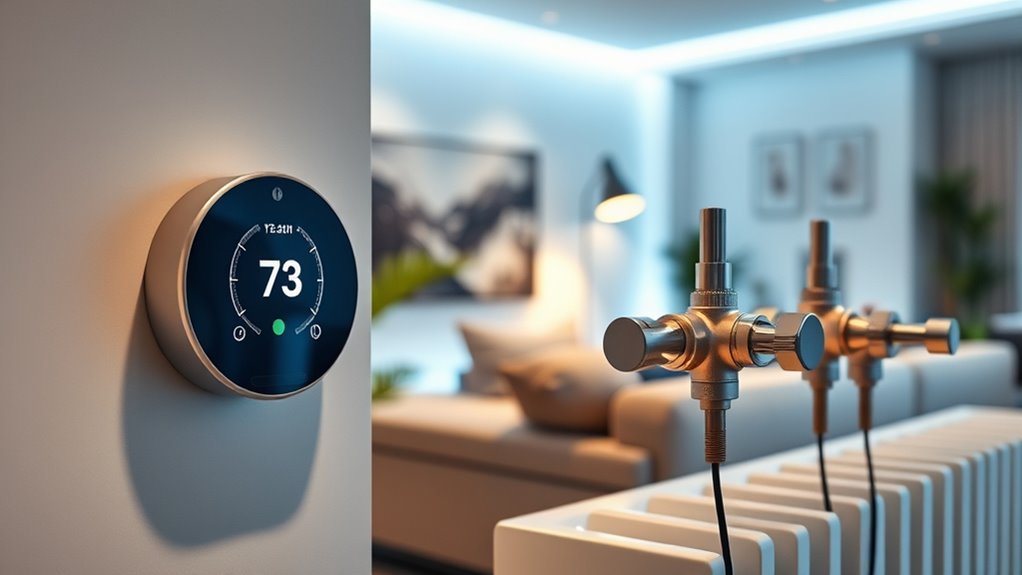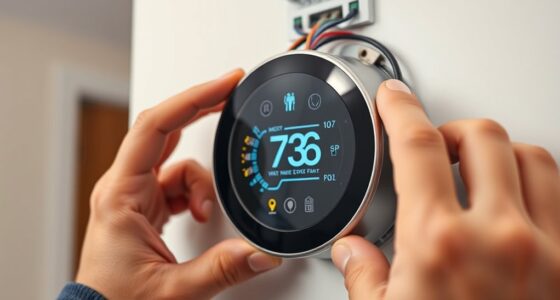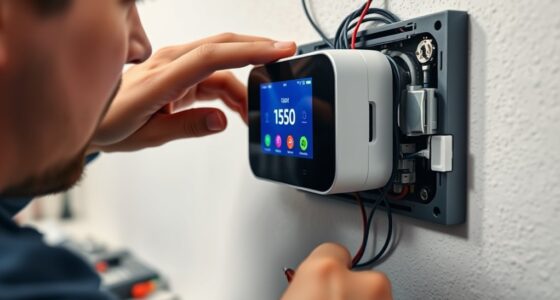To integrate your smart thermostat with smart radiator valves, first make certain both devices are compatible via protocols like Zigbee, Z-Wave, or Wi-Fi. Install the radiator valves on each radiator and connect them to your home Wi-Fi. Then, pair the valves and thermostat through their respective apps, often using Bluetooth or Wi-Fi. Once connected, you can control everything centrally and set schedules for maximum comfort and efficiency—continue to explore how to streamline your system even further.
Key Takeaways
- Verify compatibility of your smart thermostat and radiator valves with common protocols like Zigbee, Z-Wave, or Wi-Fi.
- Install radiator valves on radiators following manufacturer instructions and connect them to your home Wi-Fi network.
- Pair the radiator valves with your thermostat’s app via Bluetooth or Wi-Fi, following specific device pairing procedures.
- Integrate the radiator valves into the thermostat’s control system or app for centralized management of heating zones.
- Use automation features, schedules, and voice control options within the app to optimize and manage your heating system effectively.

Integrating a smart thermostat with smart radiator valves can substantially enhance your home’s heating efficiency and comfort. When you connect these devices, you create a seamless system that adapts to your lifestyle and preferences, ultimately leading to significant energy savings. This setup allows you to control your heating more precisely, reducing unnecessary energy consumption and lowering your utility bills. To get started, ensure your smart thermostat and radiator valves are compatible, often through common protocols like Zigbee, Z-Wave, or Wi-Fi. Once compatibility is confirmed, you’ll typically install the radiator valves on each radiator and connect them to your home’s Wi-Fi network, following the manufacturer’s instructions. After installation, you’ll need to integrate the valves into your thermostat’s app or control system, which usually involves pairing devices via Bluetooth or Wi-Fi. This integration enables centralized control, making it easier to manage temperature zones in different rooms.
A key advantage of this integration is the improved user interface, which makes managing your home’s heating straightforward. Modern smart thermostats and radiator valves come with intuitive apps that let you set schedules, adjust temperatures, and monitor energy use from your smartphone or tablet. These interfaces often include visual indicators of each radiator’s status, allowing you to see which rooms are heating and adjust settings accordingly. Some systems also support voice control through virtual assistants like Alexa or Google Assistant, providing hands-free convenience. With a well-designed user interface, you’re empowered to fine-tune your heating system with minimal effort, ensuring comfort while avoiding over-heating or wasting energy. Additionally, understanding Ford Tuning techniques can inspire innovative ways to optimize your home heating system’s performance through custom settings and configurations. Moreover, utilizing smart home integrations can streamline your control over multiple connected devices for enhanced efficiency. Incorporating energy monitoring features can give you detailed insights into your consumption patterns, helping you make more informed adjustments.
To maximize these benefits, take advantage of the system’s automation features. Set schedules that align with your daily routine, so rooms only heat when needed. Use geofencing to automatically adjust temperatures as you leave or return home. Many systems also feature learning algorithms that analyze your habits over time, optimizing heating patterns for maximum efficiency. Regularly reviewing your energy reports within the app helps identify patterns and areas for improvement. Over time, these insights can guide you toward more efficient settings, further boosting energy savings.
Frequently Asked Questions
Can I Control Multiple Zones With One Smart Thermostat?
Yes, you can control multiple zones with one smart thermostat through multi zone control, but it depends on your system’s setup. Some smart thermostats offer centralized management, allowing you to adjust settings for different areas from a single device. This setup works best if your home has compatible smart radiator valves or zoning systems that support centralized control, making it easier to manage temperature across multiple zones efficiently.
How Secure Is My Smart Home Network When Integrating Devices?
Ever wonder how secure your smart home network really is? When you integrate devices like smart thermostats and radiator valves, you’re enhancing device interoperability but may raise concerns about network security. To stay protected, guarantee your Wi-Fi has strong passwords, enable encryption, and keep firmware updated. Regularly review connected devices and limit access. Isn’t it worth taking these steps to safeguard your smart home’s security while enjoying seamless control?
Do Smart Radiator Valves Work With All Smart Thermostats?
Smart radiator valves don’t work with all smart thermostats because radiator compatibility varies depending on the thermostat types you choose. Some valves are compatible with specific brands or systems, so you need to check compatibility before purchasing. Generally, if you select a thermostat that’s compatible with your radiator valves, integration is smooth. Always verify manufacturer recommendations to guarantee seamless operation and avoid compatibility issues.
What Is the Average Installation Time for Integration?
Ever wondered how long it takes to get your smart thermostat and radiator valves working together? The installation timeline varies, but most setups take about 30 to 60 minutes. The setup duration depends on your system’s compatibility and your familiarity with smart devices. Are you ready to streamline your heating? With patience, you’ll enjoy integrated control and comfort sooner than you think.
Can I Override the System Manually if Needed?
Yes, you can manually override your system if needed. Most smart thermostats and radiator valves include manual override options for safety features or immediate temperature adjustments. You can usually do this by turning a dial or pressing a button on the device. Just remember, manual overrides may temporarily disable the automated system, so check your device’s instructions to verify safe operation and proper reactivation of the smart features afterward.
Conclusion
By integrating your smart thermostat with smart radiator valves, you’re transforming your home into a perfectly balanced, climate-controlled paradise—where every room feels just right, no matter the weather outside. Imagine never worrying about wasting energy or dealing with uneven heating again. With this setup, you’ll achieve a level of comfort so advanced, it’s like having a personal climate wizard at your fingertips, turning your home into the ultimate cozy haven you’ve always dreamed of.









